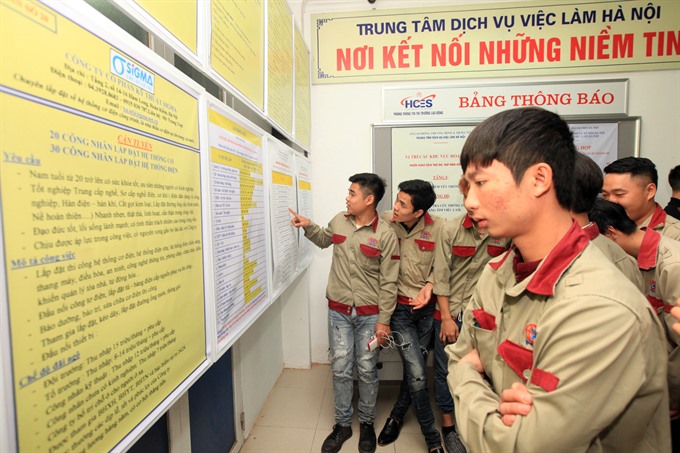 Society
Society

Forty-three per cent of the country’s young labour workforce is still underutilised, while low quality employment remains a strong hindrance to the country’s productive transformation.
 |
| People read job descriptions at a Hà Nội Job Service Centre. – VNA/VNS Photo Anh Tuấn |
HÀ NỘI – Forty-three per cent of the country’s young labour workforce is still underutilised, while low quality employment remains a strong hindrance to the country’s productive transformation.
This is a result of the School-to-work Transition Survey conducted by the General Statistics Office (GSO) with the support of the International Labour Organisation in 2015 and released yesterday.
Labour underutilisation refers to people who are unemployed, inactive and out of school, or in an irregular job (as self-employed or in a temporary paid job).
The survey finds that although 58.6 per cent of young workers were in paid employment, nearly half did not have a written contract.
Eighty per cent were also in informal employment, which means jobs that generally lack basic social and legal protection or employment benefits.
“While Việt Nam does not experience alarming high youth unemployment as in many other countries, ensuring quality jobs for the young generation remains a great test for the nation,” said ILO Việt Nam Director Chang-Hee Lee. “Many young workers are still stuck with no protection in the workplace and many others cannot get the right tools out of their schooling for today’s job market.”
Amid the unsecured job market, almost two-thirds of young students said in 2015 they preferred to work in the Government or public sector for the sake of job security, the survey reveals.
Also according to the survey, it takes much less time for university degree holders to find their first stable or satisfactory job (7,3 months, on average) than for those with a secondary education level (17,8 months).
Skills mismatch remains a problem, with 26 per cent of young working people overeducated for their jobs and 23.5 per cent undereducated.
“This means that businesses are neither fully utilising the productive capacity of many young workers nor operating at their full productivity level by employing less productive workers,” Chang-Hee Lee said.
According to a report by the Ministry of Labour, Invalids and Social Affairs (MoLISA), the unemployment rate among people of working age in 2016 was 2.3 per cent. In the third quarter of 2016, about 202,000 university degree holders were unemployed.
Minister of Labour, Invalids and Social Affairs Đào Ngọc Dung said creating jobs for young people is one of the main goals of the ministry in 2017. “To create more jobs we need the involvement of businesses, while education needs to conform to demands of the job market. At the same time, we need to better connect between jobs and workers through employment agencies,” he said. – VNS